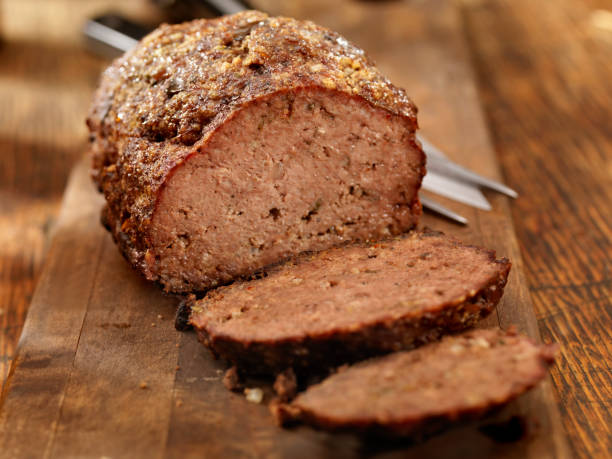Welcome to our in-depth exploration titled “How Many Calories In Meatloaf?” – a question that resonates with many seeking to balance indulgence with nutritional mindfulness. Meatloaf, a staple in American households, is often celebrated for its comforting taste and familial association. However, its nutritional profile, particularly its calorie count, frequently becomes a topic of interest among health-conscious individuals and those navigating their dietary journeys.
In this article, we dive deep into the caloric makeup of meatloaf, unraveling the layers beyond its savory exterior to provide you with a comprehensive understanding of what goes into each bite. Our expertise in nutrition and culinary arts guides this exploration, ensuring accurate, relevant, and valuable insights. We’ll dissect the impact of various ingredients, cooking methods, and serving sizes on the calorie count, offering a nuanced perspective that caters to a wide array of dietary preferences.
Contents
How Many Calories In Meatloaf?
Meatloaf can vary in calorie content depending on the ingredients used. Here are the approximate calorie counts for different types of meatloaf:
- A 4-ounce slice of meatloaf made with 80% lean ground beef contains around 350 calories.
- By using 90% lean beef instead of 80%, the calorie count for a 4-ounce slice can be reduced to about 225 calories.
- Opting for ground turkey as a healthier alternative can further lower the calorie count to approximately 192 calories for a 4-ounce slice.
- On average, a 5-ounce slice of meatloaf made with ground beef contains about 280 calories, while the same size slice made with ground turkey has around 242 calories.
These values give an overview of the calorie content in meatloaf, showing that the type of meat used and the specific recipe can significantly impact the calorie count.
Nutritional Profile of Meatloaf
See more : How Much Caffeine In Chocolate? Facts You Can’t Miss
Beyond calories, let’s explore the complete nutritional breakdown of a typical meatloaf slice:
Nutrition Facts
| Nutrient | Amount Per 1 Slice (106g) |
|---|---|
| Calories | 230 |
| Fat | 12g |
| Saturated Fat | 4.5g |
| Trans Fat | 0g |
| Cholesterol | 135mg |
| Sodium | 320mg |
| Carbohydrates | 11g |
| Fiber | 0g |
| Sugar | 3g |
| Protein | 22g |
As the numbers illustrate, meatloaf derives the majority of its calories from protein and fat. It also contains a range of vitamins and minerals like niacin, vitamin B6, iron, and zinc. Choosing whole grain breadcrumbs over plain white, and mixing in veggies like carrots, peppers, or mushrooms, can further boost the nutritional value.
Comparison to Other Main Dishes
Despite the prevalent perception of meatloaf as indulgent, its calorie and nutrition profile is on par with many other popular entrees. For example, a serving of meatloaf contains fewer calories than the same portion size of lasagna (500+ calories) or chicken parmesan (400+ calories). It has slightly more calories than chili or vegetable soup, but significantly more protein. Compared to a bacon cheeseburger, meatloaf packs fewer total calories, less fat, and more nutrition. So while decadent in flavor, meatloaf can be a balanced option when enjoyed in moderation alongside veggies as part of an overall healthy plate.
Impact of Cooking Method

Baking is the most traditional preparation for meatloaf, keeping it tender and moist. Choosing this oven-cooking method over frying reduces total fat and calories. Baking, broiling, or grilling meatloaf without added fat results in a healthier finished product. Cooking times and temperatures may need adjustment to prevent drying out. For example, baking at 350°F covered, then uncovered at a higher temperature ensures a nicely browned exterior. Microwaving is convenient, but often leaves meatloaf dense and dry. Adding a touch of olive oil or cooking spray ensures pan juices without significant added calories.
Healthier Substitutions and Variations
See more : How To Cook On A Blackstone Griddle? Easy Tips for Beginners
The versatile nature of meatloaf makes it the perfect canvas for healthy substitutions. Here are some ideas for lighter yet flavorful variations:
- Replace half the beef with finely chopped mushrooms for moisture and nutrients.
- Swap breadcrumbs for quick oats to increase fiber.
- Add shredded zucchini or spinach for an extra serving of vegetables.
- Use mashed beans or chickpeas in lieu of eggs as a vegan binder.
- Mix in shredded carrots, peppers, or other finely chopped veggies.
- Skip the traditional ketchup glaze and use tomato sauce or puree instead.
- Cook meatloaf in a loaf pan lined with lightly greased parchment paper.
The Italian style of meatloaf known as meatballs embraces flavorful additions like parmesan, parsley, garlic, and herbs. Greek variations integrate Mediterranean flavors through feta, lemon, oregano, and olives. Adventurous cooks around the world have developed their own cultural variations tailored to local cuisine.
Healthy Eating Tips
While meatloaf can be part of an overall nutritious diet, portion control remains key to keeping calories in check. Here are some tips for healthy meatloaf meals:
- Stick to a slice of meatloaf no thicker than 1 inch to control serving size.
- Round out the plate with a hearty side salad, roasted vegetables, or fresh fruit.
- Choose whole grains like brown rice, quinoa, or whole wheat couscous as a side dish.
- Share the remaining meatloaf as leftovers instead of overeating in one sitting.
- Beef up nutrition by incorporating spinach, carrots, or mushrooms within the loaf.
- Dip meatloaf in ketchup, barbecue sauce, mustard, or other condiments sparingly.
Reheating and Food Safety

Like many dishes, meatloaf can be safely stored for 3-4 days refrigerated. Reheating it to an internal temperature of 165°F kills any bacteria that may have accumulated and brings it back to palatable doneness. Microwaving is the quickest reheating method, but oven warming often yields better texture and moisture retention. Sliced portions reheat faster, helping restore the crispy edges of freshly baked meatloaf. Any leftovers should be eaten or frozen within that 3-4 day window for safety.
Conclusion: How Many Calories In Meatloaf?
Meatloaf has earned its place as a cherished American mealtime classic. This hearty baked loaf offers timeless appeal and comfort. While often seen as a high-calorie indulgence, meatloaf can be lightened up through cooking techniques and ingredient substitutions. When enjoyed in moderate portions alongside vegetables as part of an overall balanced diet, meatloaf provides a nutritious dose of protein. Just as flexibility makes it perfect for incorporating veggies or whole grains, meatloaf’s versatility extends to healthy eating too. With a few simple tweaks, cooks can transform the traditional version into a lighter mainstay suitable for regular enjoyment.

Michael J. Fanola is the chef and owner of Joe’s French Italian Inn Restaurants. He has over 30 years of culinary experience, and his restaurants have been voted “Best Italian Restaurant” by the readers of the Staten Island Advance for many years in a row. Michael is a graduate of the prestigious Culinary Institute of America, and he has worked in some of the most highly acclaimed kitchens in the country.








